
The scarlet gourds are a genus with 25 species. It is distributed in sub-Saharan Africa and with one species, C. grandis also in South and South-east Asia, and it is also introduced into the New World. Incidentally, C. grandis is also a cultivated crop and it is used for culinary and medical purposes.

Pachypodium ambongense is a species of plant in the family Apocynaceae. It was first published as a species of the genus Pachypodium in 1924 by the botanist Henri Louis Poisson.
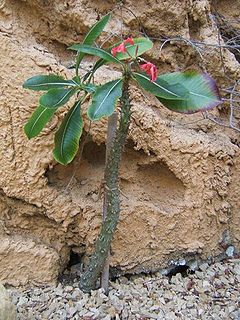
Pachypodium baronii, the Madagascar palm or bontaka, is a flowering plant in the family Apocynaceae. It has the habit of a robust shrub with a spherical or bottle-shaped trunk. It has several cylindrical branches at the top.

Smilax rotundifolia, also known as roundleaf greenbrier or common greenbrier, is a woody vine native to the southeastern and eastern United States and eastern Canada. It is a common and conspicuous part of the natural forest ecosystems in much of its native range. The leaves are glossy green, petioled, alternate, and circular to heart-shaped. They are generally 5–13 cm long. Common greenbrier climbs other plants using green tendrils growing out of the petioles.
Cycas brachycantha is a species of cycad in the genus Cycas, native to northern Vietnam where it is endemic to Bắc Kạn Province. It grows in often soil-free cracks and crevices of limestone crests and ridges under the canopy of evergreen forests. It is found in Ba Bể National Park.
Cycas cairnsiana is a species of cycad in the genus Cycas, native to northern Australia in northern Queensland on the Newcastle Range.
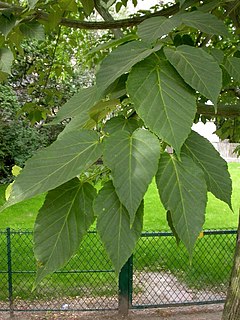
Acer davidii, or Père David's maple, is a species of maple in the snakebark maple group. It is native to China, from Jiangsu south to Fujian and Guangdong, and west to southeastern Gansu and Yunnan.
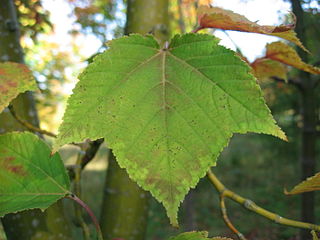
Acer rufinerve, the grey-budded snake-bark-maple, redvein maple or Honshū maple, is a species of tree in the snakebark maple group, related to Acer capillipes. It is native to mountain forests of Japan, on Honshū, Kyūshū and Shikoku.

Acer cissifolium is a maple native to Japan, from southern Hokkaidō south through Honshū and Shikoku to Kyūshū.

Thalictrum dioicum, the early meadow-rue or quicksilver-weed, is a species of herbaceous plants in the family Ranunculaceae. Plants are typically upright growing woodland natives from Colorado Rocky Mountain forests to central and eastern North America including parts of south eastern Canada. This species has dioecious plants, with male and female flowers on separate plants blooming in early to mid spring.
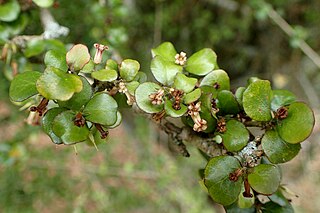
Pittosporum obcordatum, commonly called heart-leaved kohuhu or heart-leaved kohukohu or kohukohu, is a species of plant in the Pittosporaceae family. It is endemic to New Zealand, and exists both in North Island and South Island.

Eriogonum flavum is a species of wild buckwheat.

Myristica fragrans is an evergreen tree indigenous to the Moluccas of Indonesia. It is important as the main source of the spices nutmeg and mace. It is widely grown across the tropics including Guangdong and Yunnan in China, Taiwan, Indonesia, Malaysia, Grenada in the Caribbean, Kerala in India, Sri Lanka and South America.

Nepenthes andamana is a tropical pitcher plant endemic to Phang Nga Province, Thailand, where it grows near sea level in coastal savannah and grassland. It is thought to be most closely related to N. suratensis.
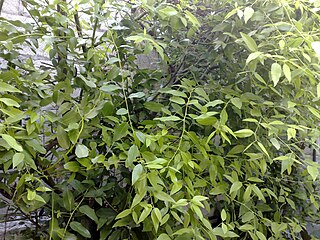
Litsea glaucescens, also called Mexican bay leaf, is an evergreen tree or shrub 3–6 metres (9.8–19.7 ft) high in the genus Litsea belonging to family Lauraceae. It is native from southern North America, mostly in Mexico. Distributed by Mexico and Central America.

Coccinia intermedia is a species of Coccinia which was first described in 2011 by Norbert Holstein.
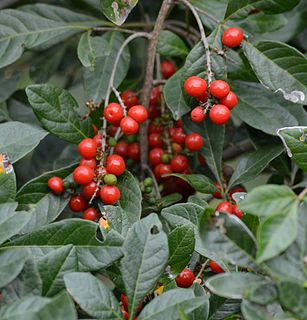
Allophylus decipiens (E.Mey.) Radlk., commonly known as the bastard taaibos, is a multi- or single-stemmed, small, evergreen tree about 3–4 m in height occurring in coastal forest, fringe forest and thickets, and wooded ravines and streams. Found up to 800 m in the southern coastal regions of the Cape Province, KwaZulu-Natal, Swaziland, along the escarpment forest of Mpumalanga, including Soutpansberg and in Mozambique. There are some 219 species in the genus of Allophylus.

Coccinia grandiflora is an East African species of Coccinia which was first described in 1895 by Alfred Cogniaux.
Coccinia pwaniensis is an East African species of Coccinia that was first described in 2010.

Coccinia abyssinica is an Ethiopian species of Coccinia which was first described by Jean-Baptiste Lamarck. The tuber is under its Oromo name anchote a well-known local crop, but also the leaves are eaten.

















